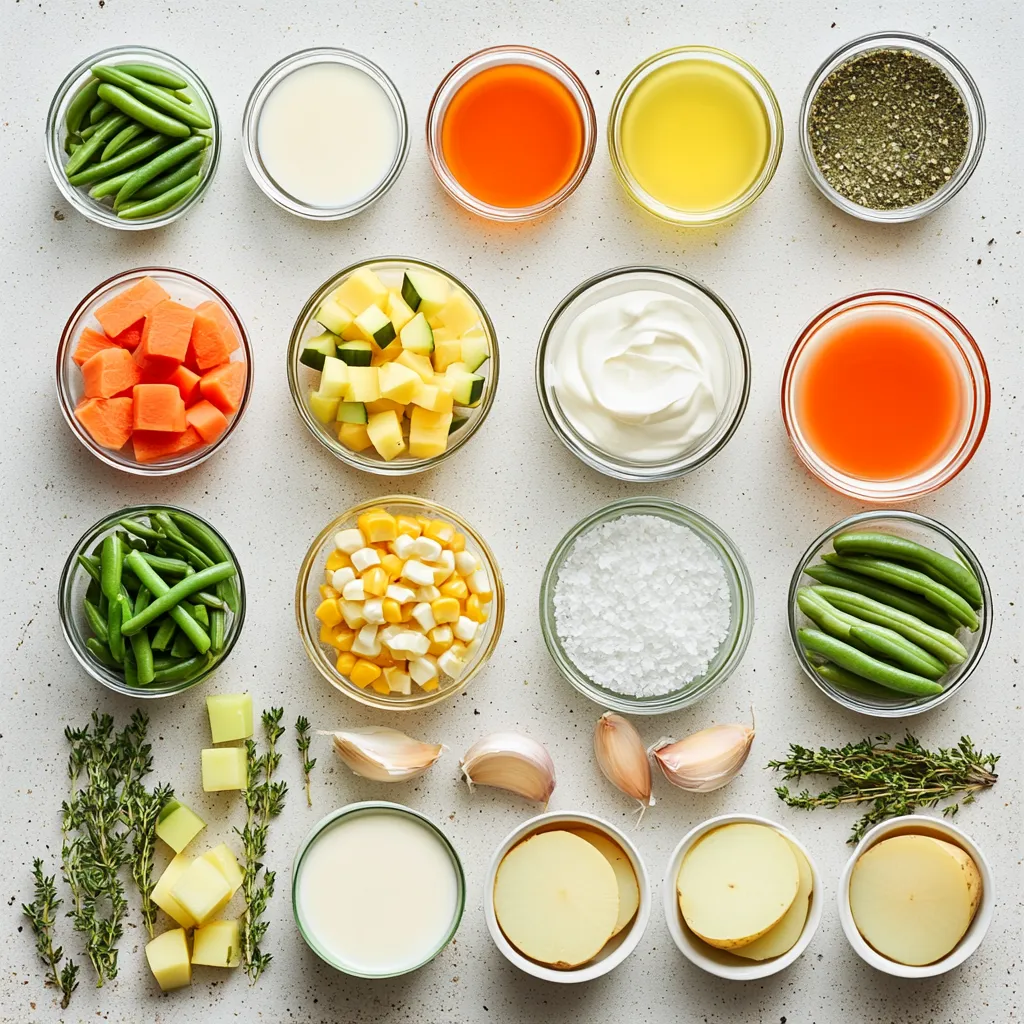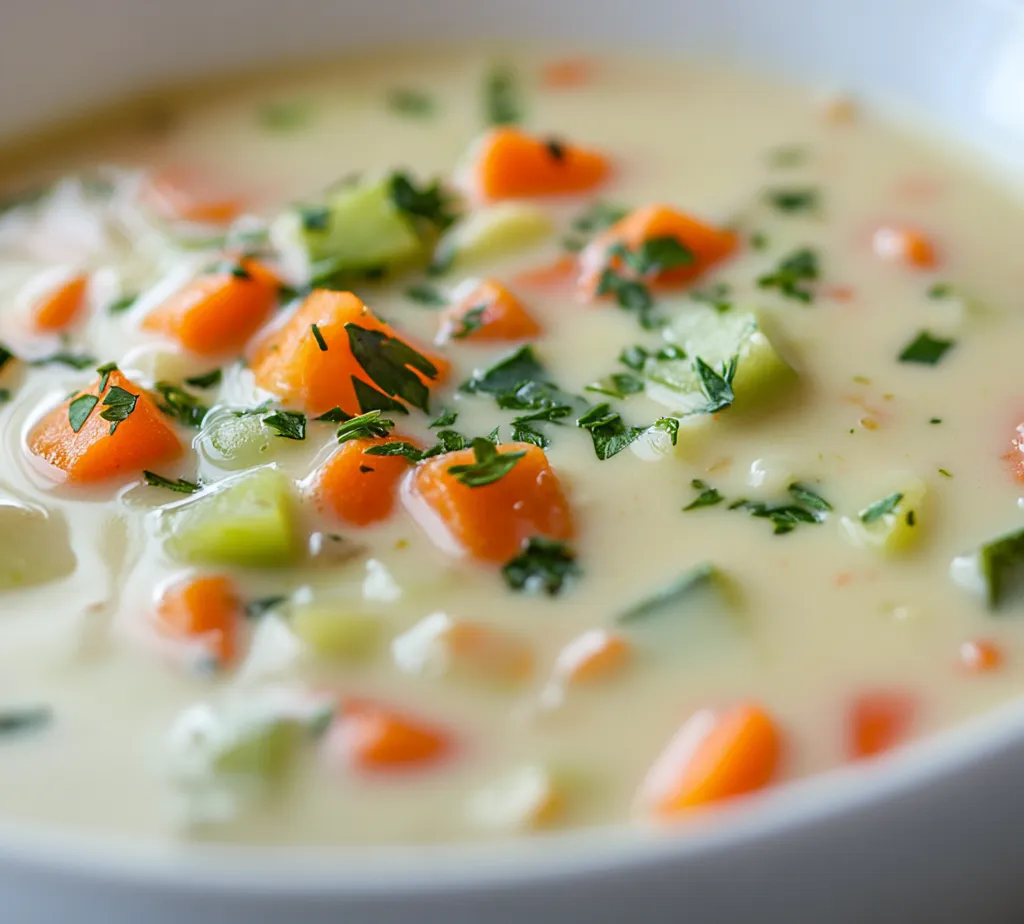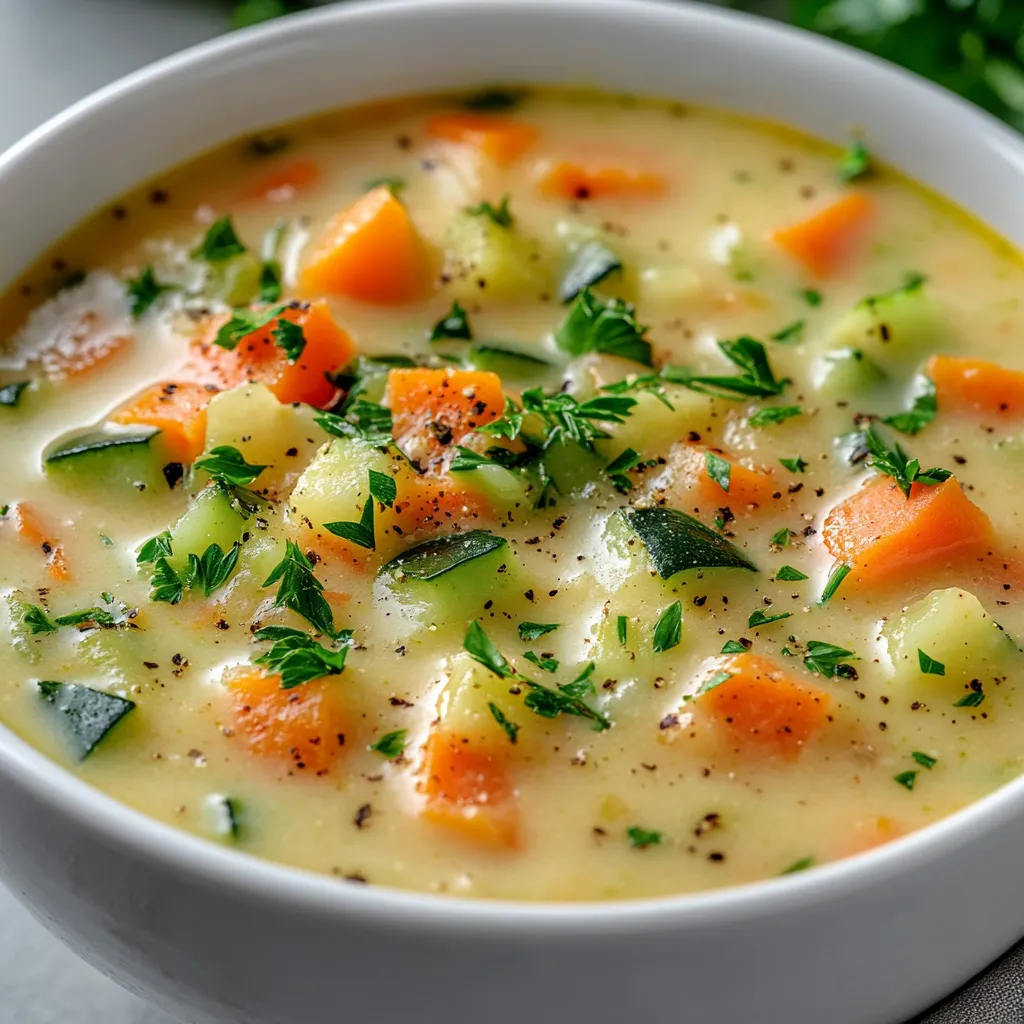Introduction
In recent years, one-pot meals have surged in popularity, and for good reason. They offer a convenient and efficient way to cook, minimizing both kitchen time and cleanup. The appeal of one-pot dishes lies in their simplicity and their ability to combine various ingredients seamlessly. Not only do they save time, but they also enhance the flavors as the ingredients meld together during cooking.
This Creamy One-Pot Vegetable Delight recipe is a perfect embodiment of all that one-pot cooking can offer. It’s not only comforting and delicious but also packed with a variety of vegetables, making it a hearty meal that resonates well with anyone looking to add more plant-based foods to their diet. This dish serves as an inviting option for cozy evenings or family gatherings and is sure to satisfy both vegetarians and meat-eaters alike.
Moreover, the addition of heavy cream—or a dairy-free alternative like coconut milk—gives this dish a rich, creamy texture that’s irresistible. This recipe is designed to showcase the natural flavors of fresh vegetables while providing the warmth and coziness that a delightful meal promises.
Recipe Overview
– Total Time: 40 minutes
– Prep Time: 10 minutes
– Cook Time: 30 minutes
– Yield/Servings: 4-6 servings
– Difficulty: Not specified in the recipe
This Creamy One-Pot Vegetable Delight not only delivers on taste but also emphasizes the importance of using fresh, seasonal ingredients. You can also adapt this recipe based on dietary needs, as coconut milk can be easily swapped for heavy cream, making this dish suitable for anyone avoiding dairy.
Ingredients
– 2 tablespoons olive oil
– 1 medium onion, finely chopped
– 3 cloves garlic, minced
– 2 medium carrots, diced
– 2 celery stalks, diced
– 1 medium potato, peeled and cubed
– 1 zucchini, diced
– 1 cup green beans, trimmed and cut into bite-sized pieces
– 1 cup corn kernels (fresh or frozen)
– 4 cups vegetable broth
– 1 cup heavy cream (or coconut milk for a dairy-free version)
– 1 teaspoon dried thyme
– 1 teaspoon dried basil
– Salt and freshly ground black pepper, to taste
– Fresh parsley, chopped (for garnish)
When selecting your vegetables, it’s best to opt for fresh, vibrant produce. Look for firm carrots, bright green beans, and smooth zucchinis. If you prefer, substitute any of these vegetables with your seasonal favorites or whatever you have on hand; this flexibility makes the recipe even more appealing.

Instructions
1. Start by heating the olive oil in a large pot over medium heat. Once hot, add the finely chopped onion and sauté for 3–4 minutes until it becomes translucent and soft.
2. Add the minced garlic to the pot and cook for an additional minute, stirring until the garlic becomes fragrant.
3. Next, incorporate the diced carrots, celery, and cubed potato into the pot. Sauté these vegetables for 5–7 minutes, stirring occasionally, until they start to soften.
4. Add the diced zucchini, chopped green beans, and corn kernels to the pot. Cook for another 3–4 minutes, allowing the flavors to meld.
5. Pour in the vegetable broth and sprinkle in the dried thyme, basil, salt, and pepper. Stir well and bring the mixture to a rolling boil.
6. Once boiling, reduce the heat to low and let the soup simmer for about 15–20 minutes, or until all the vegetables are tender and cooked through.
7. After the vegetables are tender, stir in the heavy cream (or coconut milk) and allow it to simmer for an additional 5 minutes, enhancing the creaminess of the soup.
8. Taste the soup and adjust the seasoning with more salt and pepper if needed.
9. Remove the pot from heat and ladle the soup into bowls. Garnish each serving with freshly chopped parsley for a pop of color and freshness.
By sticking closely to this recipe, you’re guaranteed a robust and flavorful soup that celebrates the simplicity of home-cooked meals. Additionally, an emphasis on preparation can greatly improve your experience. Chopping vegetables ahead of time or before turning on the stove can help streamline the cooking process while allowing you to enjoy each step with care.
Cooking Techniques
Sautéing is a fundamental technique in this recipe that plays a crucial role in developing flavors. It involves cooking food quickly in a small amount of fat over medium heat and is instrumental in releasing the aromas of carefully selected ingredients like onion and garlic.
In the first steps of the recipe, sautéing the onion until translucent not only sweetens the onion but also provides a flavorful base for the other vegetables. Likewise, incorporating garlic just after the onions, will bring an irresistible fragrance and depth to the dish.
Next, the process of simmering allows the excellent medley of vegetables to join together as they cook slowly in the vegetable broth. Simmering is a technique that involves cooking food gently and slowly with a consistent temperature, which allows for flavors to integrate fully. In this recipe, maintaining the right temperature is essential for cooking the vegetables until they achieve tenderness without losing their vibrant colors.
Adjusting the heat during the cooking process is another key to mastering these techniques. Once you achieve a boil after adding the broth and herbs, reducing the heat ensures that the dish cooks through adequately without becoming too aggressive, which may lead to mushy vegetables.
This awareness of timing and technique throughout the cooking process not only enhances the dish’s taste but can elevate your confidence in the kitchen.
Flavor Enhancement
The flavor profile of this dish is primarily elevated through the use of dried herbs—specifically thyme and basil. Thyme is robust and earthy, with a hint of mint, and it complements the natural sweetness of the vegetables perfectly. Basil, on the other hand, brings a sweet and slightly peppery flavor that brightens the overall palate.
In addition to the herbal elements, salt and freshly ground black pepper play pivotal roles in seasoning. They help to highlight the natural flavors of the vegetables while bringing depth and balance to the creamy sauce. It’s essential to taste and adjust seasonings accordingly, as fresh produce can vary in sweetness and saltiness.
For those looking to enhance the dish further, consider adding other herbs or spices such as dill, oregano, or a sprinkle of red pepper flakes for a subtle kick. Fresh herbs could also be used to garnish, transforming this simple dish into a culinary masterpiece visually and in flavor.
The blend of herbs in this Creamy One-Pot Vegetable Delight not only elevates the dish’s taste but also fosters a satisfying comfort that will surely delight any palate.

Differences between heavy cream and coconut milk: benefits and flavor implications
When choosing between heavy cream and coconut milk for this recipe, understanding the characteristics of each is crucial. Heavy cream is rich, creamy, and contributes a luxurious mouthfeel and depth of flavor. It easily thickens the soup, resulting in a hearty texture that coats the palate beautifully. Additionally, its subtle sweetness enhances the natural flavors of the vegetables without overpowering them.
On the other hand, coconut milk lends a tropical flair to the dish. While it also offers creaminess, it introduces a slightly nutty and sweet flavor profile that can transform the soup into something distinctly different. This can be particularly appealing for those seeking a dairy-free option or those who love the taste of coconut. However, it’s essential to use full-fat coconut milk for the richest texture, as light varieties can lead to a thinner consistency.
Ways to achieve the desired creaminess in the dish
Achieving the ideal creaminess in the Creamy One-Pot Vegetable Delight is essential for a satisfying bowl of soup. Aside from using heavy cream or coconut milk, there are various techniques to enhance creaminess:
– Blending some of the cooked vegetables can create a thick base without the need for additional cream. Using an immersion blender directly in the pot or transferring a portion to a standard blender can yield a smoothly pureed texture that still retains chunks of veggies.
– Incorporating blended silken tofu is another excellent option. It has a smooth consistency and neutral flavor, easily blending into the soup while boosting the protein content. This works particularly well for those avoiding dairy or looking for a vegan alternative.
– Adding a small amount of nutritional yeast not only increases creaminess but also introduces a cheesy flavor, enhancing the overall taste.
Serving Suggestions
Ideal accompaniments for the soup
When serving the Creamy One-Pot Vegetable Delight, consider pairing it with crusty bread, such as a rustic sourdough or a multigrain baguette. The bread can be used to scoop up the soup, amplifying the experience. Additionally, a side salad featuring leafy greens dressed with a light vinaigrette can provide a refreshing contrast to the rich soup.
Presentation techniques for enhanced appeal
Presentation plays an essential role in the dining experience. Serving the soup in rustic bowls or deep plates creates an inviting aesthetic. A drizzle of good-quality olive oil on top just before serving not only adds visual allure but also enhances the flavor. Consider placing some finely chopped herbs or chili flakes in the center for a pop of color and an added touch of uniqueness.
Recommendations for additional garnishes beyond parsley
While fresh parsley is a wonderful garnish, there are multiple options to elevate the soup’s visual and flavor profile. Chopped chives or green onions can add a mild onion flavor. For a bit of heat, a sprinkle of red pepper flakes or a drizzle of hot sauce can provide a kick. Toasted pumpkin seeds or sunflower seeds can introduce a crunchy texture that contrasts the smoothness of the soup.
Nutritional Benefits
Detailed analysis of the nutritional content of the main ingredients
The ingredients in the Creamy One-Pot Vegetable Delight offer numerous nutritional benefits. Carrots, for instance, are rich in beta-carotene and fiber while providing vitamins A and K. Celery contributes hydration and essential minerals like potassium. Potatoes offer complex carbohydrates and vitamin C, while zucchini adds volume and nutrients like vitamins B6 and potassium. Green beans and corn are great sources of fiber, vitamins C and A, and folate, promoting overall health.
Health benefits associated with the vegetables used
Incorporating a variety of vegetables means this soup is packed with antioxidants and phytonutrients that may help fight inflammation and support immune health. The balance of fiber helps regulate digestion, making the soup a wholesome choice for families and individuals looking to enhance their nutritional intake.
Insight into making the dish a wholesome option for families
This soup is not only rich in vitamins and minerals, but it is also low in calories when using coconut milk or heavy cream in moderation. By utilizing whole, fresh vegetables as the base, this dish encourages healthy eating habits, providing a flavorful way to increase vegetable intake in family meals.
Timing and Efficiency
Breakdown of prep time and cooking time
The Creamy One-Pot Vegetable Delight can be prepared in 10 minutes of active cooking time, followed by 30 minutes of simmering, making it a straightforward dish to prepare. The short timeframe makes it accessible for busy weeknights while still providing a fulfilling and nutritious meal.
Tips on how to streamline the process for busy weeknights
To make the cooking process even more efficient, consider prepping vegetables in advance. Dicing and storing them in airtight containers can save time on the day you plan to cook. Alternatively, many grocery stores offer pre-chopped vegetables for added convenience. Setting out all your ingredients before beginning can also reduce cooking time.
Suggestions for make-ahead options and reheating
This soup is an excellent candidate for make-ahead meals. It stores well in the refrigerator for 3-4 days, allowing the flavors to deepen. For reheating, gently warm the soup on the stove over low to medium heat, stirring frequently. If the soup thickens too much, a splash of vegetable broth or water can be added to restore its original consistency.
Variations of the Recipe
Ideas for swapping or adding different vegetables
Customization is key when making this soup. You can add or substitute vegetables based on availability or preference. For instance, sweet potatoes, peas, or bell peppers can complement the existing flavors beautifully. Leafy greens like spinach or kale can also be added towards the end of cooking for an additional nutrient boost.
Suggestions for making the dish heartier
For those desiring a heartier meal, consider introducing grains like quinoa, farro, or even lentils. These ingredients not only make the dish more filling but also enrich it with additional textures and flavors. Adding a can of chickpeas or white beans during the simmering process can further increase protein and fiber content.
Creative twists on the dish for different seasons or dietary needs
Embrace seasonal produce to keep the soup fresh and exciting. In the summer, zucchini and fresh corn shine, while root vegetables such as turnips or parsnips might be more abundant in the fall. For dietary needs, this soup can easily be adapted to various preferences, such as gluten-free diets by omitting any gluten-containing grains.
Storage and Leftovers
Best practices for storing leftovers
To ensure maximum freshness, store any leftover soup in an airtight container in the refrigerator. If you anticipate keeping it longer, freezing portions is an excellent choice. Just make sure the soup is cooled to room temperature before transferring it to freezer-safe containers.
How to reheat the soup without losing its texture
Reheating should always be done slowly to maintain the soup’s texture. Avoid boiling, as this can cause dairy to separate if heavy cream is used. Instead, heat the soup over medium heat, stirring occasionally. If the soup appears too thick after reheating, thin it out with a bit of broth or water and stir well.
Ideas for repurposing leftovers in other meals
If you have an abundance of leftovers, consider using the soup as a sauce for pasta or grain bowls. It could also serve as a base for savory casseroles or stews. Adding some cooked protein, such as shredded chicken or sautéed shrimp, can transform it into a completely different dish.
Conclusion
This Creamy One-Pot Vegetable Delight is a satisfying, velvety soup that celebrates the flavors of fresh vegetables, making it both comforting and healthy. With a prep time of just 10 minutes and a total cooking time of 40 minutes, it’s a fantastic choice for busy days. The soup’s rich texture and layered flavors make it perfect for warming up during any season.

Creamy One-Pot Vegetable Delight Recipe for Comforting Meals
Ingredients
- 2 tablespoons olive oil
- 1 medium onion finely chopped
- 3 cloves garlic minced
- 2 medium carrots diced
- 2 stalks celery diced
- 1 medium potato peeled and cubed
- 1 medium zucchini diced
- 1 cup green beans trimmed and cut into bite-sized pieces
- 1 cup corn kernels
- 4 cups vegetable broth
- 1 cup heavy cream
- 1 teaspoon dried thyme
- 1 teaspoon dried basil
- Salt and freshly ground black pepper to taste
- Fresh parsley chopped, for garnish
Instructions
- Heat olive oil in a large pot over medium heat.
- Add chopped onion and sauté for 3-4 minutes until translucent.
- Stir in minced garlic and cook for 1 minute until fragrant.
- Add diced carrots, celery, and cubed potato; sauté for 5-7 minutes.
- Incorporate diced zucchini, green beans, and corn; cook for 3-4 minutes.
- Pour in vegetable broth and add thyme, basil, salt, and pepper; bring to a boil.
- Reduce heat to low and simmer for 15-20 minutes until vegetables are tender.
- Stir in heavy cream and simmer for an additional 5 minutes.
- Adjust seasoning with salt and pepper if needed.
- Ladle soup into bowls and garnish with chopped parsley.

